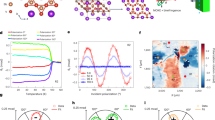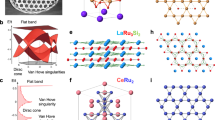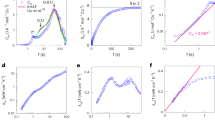Abstract
In magnetic crystals, despite the explicit breaking of time-reversal symmetry, two equilibrium states related by time reversal are always energetically degenerate. In ferromagnets, this time-reversal degeneracy is reflected in the hysteresis of the magnetic field dependence of the magnetization and, if metallic, in that of the anomalous Hall effect (AHE). Under time-reversal, both these quantities change signs but not their magnitude. Here we show that a time-reversal-like degeneracy appears in the metallic kagome spin ice HoAgGe when magnetic fields are applied parallel to the kagome plane. We find vanishing hysteresis in the field dependence of the magnetization at low temperature, but finite hysteresis in the field-dependent AHE. This suggests the emergence of states with nearly the same energy and net magnetization but different sizes of the AHE and of the longitudinal magnetoresistance. By analysing the experimental data and a minimal tight-binding model, we identify a time-reversal-like operation connecting these near-degenerate states, which is related to the non-trivial distortion of the kagome lattice in HoAgGe. Our work demonstrates the diagnostic power of transport phenomena for identifying hidden symmetries in frustrated spin systems.
This is a preview of subscription content, access via your institution
Access options
Access Nature and 54 other Nature Portfolio journals
Get Nature+, our best-value online-access subscription
$29.99 / 30 days
cancel any time
Subscribe to this journal
Receive 12 print issues and online access
$209.00 per year
only $17.42 per issue
Buy this article
- Purchase on Springer Link
- Instant access to full article PDF
Prices may be subject to local taxes which are calculated during checkout






Similar content being viewed by others
Data availability
All data presented in this paper, if not present in the main text or supplementary materials, are available from the corresponding authors upon reasonable request. Source data are provided with this paper.
Code availability
The code for the theoretical analyses and model calculations of this study is available from the corresponding authors upon reasonable request.
References
Balents, L. et al. Spin liquids in frustrated magnets. Nature 464, 199–208 (2010).
Harris, M. J. et al. Geometrical frustration in the ferromagnetic pyrochlore Ho2Ti2O7. Phys. Rev. Lett. 79, 2554–2557 (1997).
Ramirez, A. P. et al. Zero-point entropy in ‘spin ice’. Nature 399, 333–335 (1999).
Bramwell, S. T. & Gingras, M. J. P. Spin ice state in frustrated magnetic pyrochlore materials. Science 294, 1495–1501 (2001).
Castelnovo, C., Moessner, R. & Sondhi, S. L. Magnetic monopoles in spin ice. Nature 451, 42–45 (2008).
Morris, D. J. P. et al. Dirac strings and magnetic monopoles in the spin ice Dy2Ti2O7. Science 326, 411–414 (2009).
Fennell, T. et al. Magnetic coulomb phase in the spin ice Ho2Ti2O7. Science 326, 415–417 (2009).
Hall, E. H. XVIII. On the “rotational coefficient” in nickel and cobalt. Lond. Edinb. Dublin Philos. Mag. J. Sci. 12, 157–172 (1881).
Nagaosa, N., Sinova, J., Onoda, S., MacDonald, A. H. & Ong, N. P. Anomalous Hall effect. Rev. Mod. Phys. 82, 1539–1592 (2010).
Machida, Y., Nakatsuji, S., Onoda, S., Tayama, T. & Sakakibara, T. Time-reversal symmetry breaking and spontaneous Hall effect without magnetic dipole order. Nature 463, 210–213 (2010).
Udagawa, M. & Moessner, R. Anomalous Hall effect from frustration-tuned scalar chirality distribution in Pr2Ir2O7. Phys. Rev. Lett. 111, 036602 (2013).
Tomizawa, T. & Kontani, H. Anomalous Hall effect in the t2g orbital kagome lattice due to noncollinearity: significance of the orbital Aharonov–Bohm effect. Phys. Rev. B 80, 100401(R) (2009).
Chen, H., Niu, Q. & MacDonald, A. H. Anomalous Hall effect arising from noncollinear antiferromagnetism. Phys. Rev. Lett. 112, 017205 (2014).
Kübler, J. & Felser, C. Non-collinear antiferromagnets and the anomalous Hall effect. Europhys. Lett. 108, 67001 (2014).
Nakatsuji, S., Kiyohara, N. & Higo, T. Large anomalous Hall effect in a non-collinear antiferromagnet at room temperature. Nature 527, 212–215 (2015).
Nayak, A. K. et al. Large anomalous Hall effect driven by a nonvanishing Berry curvature in the noncolinear antiferromagnet Mn3Ge. Sci. Adv. 2, e1501870 (2016).
Sürgers, C., Fischer, G., Winkel, P. & Löhneysen, H. V. Large topological Hall effect in the non-collinear phase of an antiferromagnet. Nat. Commun. 5, 3400 (2014).
Liu, Z. Q. et al. Electrical switching of the topological anomalous Hall effect in a non-collinear antiferromagnet above room temperature. Nat. Electron. 1, 172–177 (2018).
Zhao, K. et al. Anomalous Hall effect in the noncollinear antiferromagnetic antiperovskite Mn3Ni1−xCuxN. Phys. Rev. B 100, 045109 (2019).
Zhou, X. et al. Spin-order dependent anomalous Hall effect and magneto-optical effect in the noncollinear antiferromagnets Mn3XN with X = Ga, Zn, Ag, or Ni. Phys. Rev. B 99, 104428 (2019).
Gurung, G., Shao, D.-F., Paudel, T. R. & Tsymbal, E. Y. Anomalous Hall conductivity of noncollinear magnetic antiperovskites. Phys. Rev. Mater. 3, 044409 (2019).
Šmejkal, L., González-Hernández, R., Jungwirth, T. & Sinova, J. Crystal time-reversal symmetry breaking and spontaneous Hall effect in collinear antiferromagnets. Sci. Adv. 6, eaaz8809 (2020).
Li, X., MacDonald, A. H. & Chen, H. Quantum anomalous Hall effect through canted antiferromagnetism. Preprint at https://doi.org/10.48550/arXiv.1902.10650 (2019).
Xiao, D., Chang, M.-C. & Niu, Q. Berry phase effects on electronic properties. Rev. Mod. Phys. 82, 1959–2007 (2010).
Chen, H. et al. Manipulating anomalous Hall antiferromagnets with magnetic fields. Phys. Rev. B 101, 104418 (2020).
Onsager, L. Reciprocal relations in irreversible processes. II. Phys. Rev. 38, 2265 (1931).
Xiao, C. et al. Linear magnetoresistance induced by intra-scattering semiclassics of Bloch electrons. Phys. Rev. B 101, 201410(R) (2020).
Wang, Y. et al. Antisymmetric linear magnetoresistance and the planar Hall effect. Nat. Commun. 11, 216 (2020).
Wolf, M. & Schotte, K. D. Ising model with competing next-nearest-neighbour interactions on the Kagome lattice. J. Phys. A: Math. Gen. 21, 2195–2209 (1988).
Takagi, T. & Mekata, M. Magnetic ordering of Ising spins on Kagomé lattice with the 1st and the 2nd neighbor interactions. J. Phys. Soc. Jpn 62, 3943–3953 (1993).
Wills, A. S., Ballou, R. & Lacroix, C. Model of localized highly frustrated ferromagnetism: the kagomé spin ice. Phys. Rev. B 66, 144407 (2002).
Matsuhira, K., Hiroi, Z., Tayama, T., Takagi, S. & Sakakibara, T. A new macroscopically degenerate ground state in the spin ice compound Dy2Ti2O7 under a magnetic field. J. Phys. Condens. Matter 14, L559 (2002).
Tabata, Y. et al. Kagomé ice state in the dipolar spin ice Dy2Ti2O7. Phys. Rev. Lett. 97, 257205 (2006).
Möller, G. & Moessner, R. Magnetic multipole analysis of kagome and artificial spin-ice dipolar arrays. Phys. Rev. B 80, 140409(R) (2009).
Chern, G.-W., Mellado, P. & Tchernyshyov, O. Two-stage ordering of spins in dipolar spin ice on the kagome lattice. Phys. Rev. Lett. 106, 207202 (2011).
Chern, G.-W. & Tchernyshyov, O. Magnetic charge and ordering in kagome spin ice. Phil. Trans. R. Soc. A 370, 5718–5737 (2012).
Qi, Y., Brintlinger, T. & Cumings, J. Direct observation of the ice rule in an artificial kagome spin ice. Phys. Rev. B 77, 094418 (2008).
Ladak, S., Read, D. E., Perkins, G. K., Cohen, L. F. & Branford, W. R. Direct observation of magnetic monopole defects in an artificial spin-ice system. Nat. Phys. 6, 359–363 (2010).
Dun, Z. L. et al. Magnetic ground states of the rare-earth tripod kagome lattice Mg2RE3Sb3O14 (RE = Gd, Dy, Er). Phys. Rev. Lett. 116, 157201 (2016).
Xiao, D. et al. Berry phase correction to electron density of states in solids. Phys. Rev. Lett. 95, 137204 (2005).
Thonhauser, T. et al. Orbital magnetization in periodic insulators. Phys. Rev. Lett. 95, 137205 (2005).
Shi, J. et al. Quantum theory of orbital magnetization and its generalization to interacting systems. Phys. Rev. Lett. 99, 197202 (2007).
Zhao, K. et al. Realization of the kagome spin ice state in a frustrated intermetallic compound. Science 367, 1218–1223 (2020).
Gopalan, V. & Litvin, D. B. Rotation-reversal symmetries in crystals and handed structures. Nat. Mater. 10, 376–381 (2011).
VanLeeuwen, B. K. & Gopalan, V. The antisymmetry of distortions. Nat. Commun. 6, 8818 (2015).
Li, N. et al. Low-temperature transport properties of the intermetallic compound HoAgGe with a kagome spin-ice state. Phys. Rev. B 106, 014416 (2022).
Dubovik, V. M. & Tugushev, V. V. Toroid moments in electrodynamics and solid-state physics. Phys. Rep. 187, 145–202 (1990).
Chen, H. Electronic chiralization as an indicator of the anomalous Hall effect in unconventional magnetic systems. Phys. Rev. B 106, 024421 (2022).
Ye, L. et al. Electronic transport on the Shastry–Sutherland lattice in Ising-type rare-earth tetraborides. Phys. Rev. B 95, 174405 (2017).
Morosan, E. et al. Thermodynamic and transport properties of RAgGe (R=Tb–Lu) single crystals. J. Magn. Magn. Mater. 277, 298–321 (2004).
Prozorov, R. & Kogan, V. G. Effective demagnetizing factors of diamagnetic samples of various shapes. Phys. Rev. Appl. 10, 014030 (2018).
Tokiwa, Y. & Gegenwart, P. High-resolution alternating-field technique to determine the magnetocaloric effect of metals down to very low temperatures. Rev. Sci. Instrum. 82, 013905 (2011).
Petříček, V., Dušek, M. & Palatinus, L. Crystallographic Computing System JANA2006: general features. Z. Kristallogr. Cryst. Mater. 229, 345–352 (2014).
Acknowledgements
We thank O. Tchernyshyov, M. Udagawa, H. Deng, I. Kezsmarki, J. Shen, H. Ren, S. Su, T. Dong and N. Wang for helpful discussions and experimental support. The work in Augsburg (K.Z., Y.T. and P.G.) was supported by the German Research Foundation (DFG) through SPP1666 (project no. 220179758), TRR80 (project no. 107745057) and TRR360 (project no. 492547816) and via the Sino-German Cooperation Group on Emergent Correlated Matter. K.Z. acknowledges the support by the National Key R&D Program of China (Grant No. 2023YFA1406003), National Natural Science Foundation of China (Grants No. 12274015), the Beijing Nova Program (Grant No. Z211100002121095), and the Fundamental Research Funds for the Central Universities. H.C. acknowledges the support by NSF CAREER grant DMR-1945023. A portion of this work was conducted at the Synergetic Extreme Condition User Facility (SECUF).
Author information
Authors and Affiliations
Contributions
K.Z. and P.G. proposed the experiments. K.Z. synthesized single crystals and measured magnetic properties, specific heat and electronic transport properties. Y.T. conducted magnetic Grüneisen parameter measurements. H.C. proposed the theoretical analysis and provided model calculations. K.Z., H.C. and P.G. wrote the manuscript with input from all authors.
Corresponding authors
Ethics declarations
Competing interests
The authors declare no competing interests.
Peer review
Peer review information
Nature Physics thanks Hiroaki Ishizuka and the other, anonymous, reviewer(s) for their contribution to the peer review of this work.
Additional information
Publisher’s note Springer Nature remains neutral with regard to jurisdictional claims in published maps and institutional affiliations.
Supplementary information
Supplementary Information
Supplementary Notes 1–15, Figs. 1–34 and Tables 1 and 2.
Source data
Source Data Fig. 1
The anomalous part \({\rho }_{{ca}}^{\rm{AH}}\) (constant-in-field) of the Hall resistivity \({\rho }_{{ca}}\), together with corrected magnetization M(H) data (Fig. 1b); summary of magnetic susceptibility, magnetization M(H), magnetic specific heat Cmag and magnetic Grüneisen parameter Γmag of HoAgGe under H//b (Fig. 1c).
Source Data Fig. 2
The magnetization M, a- and c-axis MR ρa and ρc, as well as the Hall resistivity ρca and conductivity σac of HoAgGe under H//b at various temperatures.
Source Data Fig. 3
The magnetic specific heat Cmag, magnetic Grüneisen parameter Γmag, magnetic entropy Smag and Hall resistivity ρca of HoAgGe at 8 K (Fig. 3a) and 3 K (Fig. 3b).
Source Data Fig. 4
The magnetic susceptibility of HoAgGe under H along c and b axes (Fig. 4a); the magnetization (M) under H//c at 2 K, with dM/dH curves (Fig. 4b); the a-axis MR ρa and the Hall resistivity ρab at 2 K under H//c (Fig. 4c).
Source Data Fig. 5
Band structure and Berry-curvature-related quantities orbital magnetization and linear magnetoconductivity intrinsic AHC (Fig. 5c); intrinsic AHC, Berry-curvature-contributed linear magnetoconductivity and orbital magnetization (Fig. 5d–f).
Source Data Fig. 6
The Hall resistivity ρca (Fig. 6a) and symmetric part of the raw Rca signal (Fig. 6b) of HoAgGe obtained using different field-sweep protocols under H//b at 2 K.
Rights and permissions
Springer Nature or its licensor (e.g. a society or other partner) holds exclusive rights to this article under a publishing agreement with the author(s) or other rightsholder(s); author self-archiving of the accepted manuscript version of this article is solely governed by the terms of such publishing agreement and applicable law.
About this article
Cite this article
Zhao, K., Tokiwa, Y., Chen, H. et al. Discrete degeneracies distinguished by the anomalous Hall effect in a metallic kagome ice compound. Nat. Phys. 20, 442–449 (2024). https://doi.org/10.1038/s41567-023-02307-w
Received:
Accepted:
Published:
Issue Date:
DOI: https://doi.org/10.1038/s41567-023-02307-w
This article is cited by
-
Electronic transport probes a hidden state
Nature Physics (2024)



